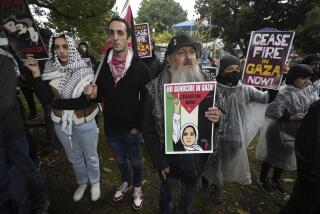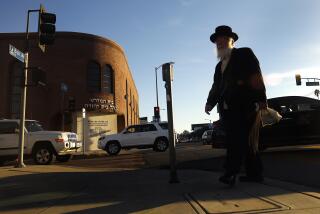Retiring Senior Rabbi Looks Back on Changes in Judaism
WEST HILLS â He has enjoyed the longest stretch by any rabbi at a major synagogue in the San Fernando Valley--nearly 38 years.
Yet, for more than a month after suffering a heart attack in November 1996, Rabbi Elijah âEliâ Schochet said that one synagogue member after another told him what they never told him before--how something the rabbi said or did had really helped them.
âNow, word of my intention to retire has triggered the same reaction that [a sign of] my mortality did,â said Schochet, sitting in his office at the 2-year-old, $7-million complex of Shomrei Torah Synagogue.
âSomeone just told me that she would have committed suicide had it not been for our conversation at a particular juncture in her life when she was down,â Schochet said. âI was embarrassed, because although I vaguely remembered the conversation, I never had the sense that she was at a critical moment.â
Schochet (pronounced SHOW-ket), who will be 64 in May, expects that it may be many months before the nearly 800-family congregation has a new senior rabbi because the search committee only recently began its work.
Even when a successor arrives, Schochet will fade away rather than disappear, he said, anticipating that some families will want him to conduct weddings and bar and bat mitzvah ceremonies.
âI have not envied itinerant rabbis who bounce from pulpit to pulpit,â he said. âThey can recycle their sermons very easily, but there isnât that long-term connection that makes it all so authentic.â
In fact, Schochet, who grew up in Chicago, Los Angelesâ Boyle Heights and the Westside, has never worked for another synagogue. After graduating from Conservative Judaismâs Jewish Theological Seminary in New York City in 1960, he became the first full-time rabbi of what was then the 1-year-old Congregation Beth Kodesh in Canoga Park--two dozen families meeting in a house behind a gas station at Saticoy Street and Topanga Canyon Boulevard.
*
He also had the chance to take a synagogue pulpit in Highland Park. âIt was an established congregation, but it was older and in decline,â he said.
The fledgling congregation in Canoga Park was the only synagogue west of Reseda Boulevard of about a half-dozen synagogues in the San Fernando Valley.
âThe Jewish move to the Valley really hadnât begun yet; it took a pioneering spirit to do so,â he added.
As Congregation Beth Kodesh grew, it rented space from Unitarian, Presbyterian and Southern Baptist churches. In 1962 it bought property on Shoup Avenue, then moved a vacant church building there and converted it into a synagogue.
In 1994, Beth Kodesh merged with Temple Beth Ami of Reseda and the combined congregation took a new name, Shomrei Torah Synagogue. By then, the Schochet-led congregation had already started fund-raising and planning for construction of a large synagogue on Valley Circle Boulevard. Shomrei Torah moved to the new site in mid-1996, creating a small âSynagogue Rowâ with Temple Solael and Temple Aliyah to the south on the same street.
Paying for the 10-acre site, the 26,000-square-foot synagogue and the two-story education building is a financial challenge, Schochet said. âBut it is a beautiful area with a lot of young families, a good level of involvement and affiliation.â
Despite the pleasures of dealing with more than one generation in families, Schochet expressed a common frustration of clergy who lead congregations, whether Jewish or Christian.
âThe tough part is that you are a general practitioner when everybody else is a specialist,â he said. âThere are only so many hours in a day to deal with the spectrum of problems.â
*
The rabbi said that he did his graduate work in psychology and is licensed as a marriage counselor. âStill, I donât consider myself adequate as a therapist,â said Schochet, indicating that a rabbi or pastor rarely has time to cultivate special skills.
Nevertheless, Schochet did find time to teach part time at the University of Judaism in Sepulveda Pass and write six books on topics raised in his adult education classes.
Two books dealt in part with Jewish mysticism, a topic of recent interest among many Jews and one that Schochet views critically.
In âAmalek,â the name of an enemy that attacked the Israelites after their exodus from ancient Egypt, Schochet wrote about amalek as it was transformed into a metaphysical enemy in cabalistic speculation in medieval Judaism. âThe book discusses the phenomenon of evil in cabalistic thought,â he said.
In âThe Hasidic Movement and the Gaon of Vilna,â published in 1994, Schochet wrote about his 18th-century ancestor, âwho came out very strongly against the Hasidic movement in its inception because in part he was very concerned about popularized mysticism.â His influential Lithuanian forebearer, Rabbi Elijah, at one point excommunicated the Hasidic movement because of dangers he saw in it.
âMysticism is exciting and enervating; it is thrilling, it can be inspiring,â said Schochet in agreeing with his ancestor. âBut both student and teacher need to be stable, mature and grounded in a Jewish framework of texts and their interpretations,â he said.
Not that Schochet wants mainstream synagogues to return to the drier, low-key religion of the 1960s. âWe used to give a lot of book reviews as sermons then, and somehow we were sophisticates who talked about religion from a sociological vantage point,â he said.
âToday,â he said happily, âspirituality is in, God is definitely in, and there is a hunger for meaning, especially among the young ones.â
More to Read
Sign up for Essential California
The most important California stories and recommendations in your inbox every morning.
You may occasionally receive promotional content from the Los Angeles Times.










